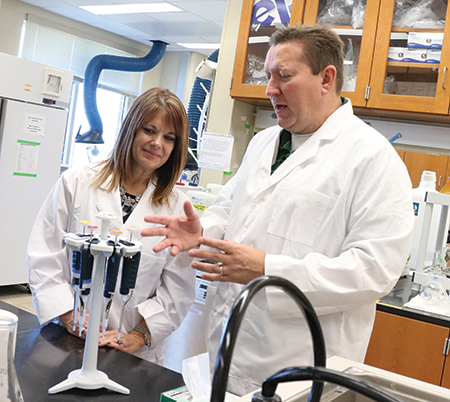Going Green in the Lab
If you really want to change the world, you’ll need to get teachers on board. And that’s exactly what a Yale-led group of molecular researchers is doing with Baylor.
In summer 2015, teachers from Texas and Washington state came to the Baylor campus for a two-week professional development experience designed by School of Education associate professor Dr. Suzanne Nesmith; Melissa Mullins, environmental education specialist; and Dr. Bryan Brooks, professor of environmental science and biomedical studies, as part of a larger project funded by the National Science Foundation (NSF). (Nesmith and Brooks are pictured, above.)
Baylor’s involvement started with Brooks, who is co-principal investigator with colleagues from Yale University, George Washington University and the University of Washington on the $4.5 million NSF grant.
The group is working on a molecular design project — Molecular Design Research Network (MoDRN: modrn.yale.edu) — employing “green chemistry” to identify the attributes of molecules that make chemicals toxic and to develop new molecules with fewer detrimental attributes for public health and the environment.
“We already design chemicals this way in medical applications,” Brooks said. “We design and manage medicines to make sure these molecules have a desired effect without causing harmful side effects. We need to apply that principle to the design of other industrial chemicals.”
The project includes a strong educational element designed to influence everyone from chemical company executives to high school students and make sure the research has impact.
Brooks had previously worked with Nesmith, so he knew her expertise in science education and qualitative research; both elements were key to MoDRN’s outreach aspirations.
"The teachers brought different perspectives based on their specialty."
~ Dr. Suzanne Nesmith
Nesmith and Brooks received a supplemental NSF grant of $71,582 to fund the summer 2015 program. The 12 teachers, who were selected through a competitive application process, worked in four teams, with a high school teacher specializing in biology, chemistry and environmental science on each team. “The teachers brought different perspectives based on their specialty,” Nesmith noted.
The teachers spent one week in a Baylor laboratory where they conducted inquiry-based experiments to test consumer products for environmental toxicity. “They used different dilutions of solutions, tested for pH levels and dissolved oxygen, and introduced daphnia (small aquatic crustaceans) to test for toxicity of cleaning products by observing the effects on the organisms,” Nesmith said. At the end of the week, the teachers presented their findings.
During the second week, the teachers moved to the Baylor Research Innovation Collaborative (BRIC) labs of the Region 12 Educational Service Center, where Region 12’s Judy York, Nesmith and Mullins led them in developing lesson plans based on the previous week’s learning. Nesmith conducted pre- and post-professional development surveys, and, as the teachers implement the plans in their classrooms this year, Nesmith is visiting to evaluate the overall impact of the experience. Eventually, the teacher-developed lessons will be included in the educational materials on the MoDRN website.
Nesmith and Brooks have secured a second supplemental NSF grant, this time for $71,088, to reach more teachers in the summer of 2016. For round two, teachers will be recruited from schools that serve populations that are underrepresented in STEM fields.
